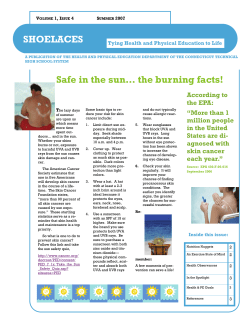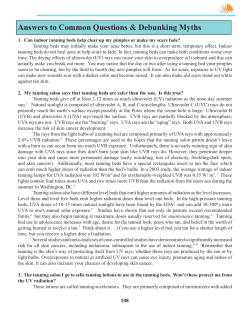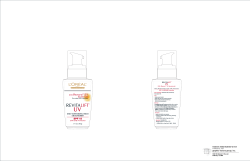
Document 163967
More Myths and Facts… “No harsh glare, so no goggles or eye shades are necessary.” Studies show that too much exposure to ultraviolet rays, including UVA rays, can damage the retina. Overexposure can burn the cornea, and repeated exposure over many years can change the structure of the lens so that it begins to cloud, forming a cataract. Left untreated, cataracts can cause blindness. The Food and Drug Administration requires tanning salons to direct all customers to use protective eyewear. Closing your eyes, wearing ordinary sunglasses, and using cotton wads do not protect the cornea from the intensity of UV radiation in tanning devices. Long-term exposure to natural sunlight also can result in eye damage, but in the sun, people generally are more aware that their eyelids are burning. Under indoor UV lights, exposed skin intensity of lights used in tanning devices is much greater – and potentially more damaging to the eyes – than the intensity of UV rays in natural sunlight Mission Statement The Pat Walker Health Center, University Health Services provides professional and comprehensive medical care, mental health care, health education, and health promotion for a diverse community of students, faculty, and staff. We, the University Health Services Staff of the Pat Walker Health Center, have a commitment to physical, mental, spiritual, social, and emotional health, the highest standards of quality, and appreciation of the value of each individual. Through these endeavors we support the educational mission of the University of Arkansas and the growth of each individual. So You Want To Get a Tan… Pat Walker Health Center University Health Services 525 N. Garland Avenue Fayetteville, AR 72701 (479) 575-4451 TTY (479) 575-4124 Website: health.uark.edu “No danger in exposure or burning.” Whether you tan indoors our out, studies show the combination of ultraviolet rays and some medicines, birth control pills, cosmetics, and soaps may accelerate skin burns or produce painful adverse skin reactions, such as rashes. In addition, tanning devices may induce common lightsensitive skin ailments like cold sores. Pat Walker Health Center Accredited by Accreditation Association for Ambulatory Health Care A Member of the Division of Student Affairs Last updated 12/09 Pat Walker Health Center University Health Services 525 N. Garland Avenue Fayetteville, AR 72701 (479) 575-4451 TTY (479) 575-4124 Website: health.uark.edu TANNING BEDS Good or Bad? There is no such thing as a healthy tan, whether obtained at the beach or at a tanning salon. A tan is the skin’s response to an overdose of ultraviolet (UV) radiation and is a sign that injury has occurred. Lamps used at tanning salons emit two to three times the amount of UVA that reaches the earth outdoors. While tanning beds are often advertised as a safe alternative to tanning under the sun because of the lack of ultraviolet B (UVB) radiation, scientists now understand that UVA is as responsible as UVB for causing photo aging of the skin, which can lead to wrinkles, age spots, and skin cancers. Different skin types respond differently to the UV radiation. Short-term side effects from tanning beds include skin redness, itching, dry skin, and nausea. Long-term effects include the development of skin cancers, eye injury, premature wrinkling of the skin, rashes from the interaction of the UVA and common medication, or even unusual diseases like polymorphic light eruption, commonly known as “sun poisoning.” While UVA rays are less likely to cause burning than UVB rays, they are suspected to have links to malignant melanoma and immune system damage. Did You Know… • • • • • Skin Cancer is becoming more common at an earlier age A tan is like a callus—protecting your skin A 4% death rate is on the rise each year Skin cancer is not easily cured People with skin cancer do not see the effects until years down the road Test Your Tanning IQ True or False? 1. Any sun exposure can cause skin cancer 2. People catch AIDS or herpes from tanning beds 3. There is no such thing as a safe tan 4. Tanning isn’t as popular as it used to be 5. Dermatologists say tanning causes melanoma 6. There was a women who fried her internal organs by tanning too much 7. Skin cancer affects more people than any other cancer 8. Sun exposure could actually help prevent cancer 9. Skin cancer rates are rising because more people tan now than in years past 10. People who receive regular sun exposure have a lower incidence of malignant melanoma 11. Indoor tanning is riskier than outdoor 12. Indoor tanning is helping to reduce the incidence of sunburn 13. Indoor tanning is like a cigarette for your skin Answers: 1.T, 2.F, 3.T, 4.F, 5.T, 6.F, 7.T, 8.F, 9.T, 10.F, 11.T, 12.F, 13.T Myths and Facts: “Tan year round without the harmful side effects often associated with natural sunlight.” Exposure to tanning salon rays increase the damage caused by sunlight. This occurs because ultraviolet light actually thins the skin, making it less able to heal. Unprotected exposure to ultraviolet rays also results in premature skin aging. A tan is damaged skin that is more likely to wrinkle and sag than skin that hasn’t been tanned. Over time, you may notice certain undesirable changes in the way your skin looks and heals. According to some dermatologists, skin that has a dry, wrinkled, leathery appearance in middle age is a result of UV exposure that occurred in youth. “You can achieve a deep year-round tan with gentle, comfortable, and safe UVA light.” Ultraviolet light is divided into two wavelength bands. Shortwave ultraviolet rays called UVB can burn the outer layer of skin. Longwave ultraviolet rays called UVA penetrate more deeply and can weaken the skin’s inner connective tissue. Long-term exposure to the sun and to artificial sources of ultraviolet light contributes to the risk of developing skin cancer. Two types of skin cancer, basal cell and squamos cell, are treatable if detected early. Melanoma, another type of skin cancer, can be fatal.
© Copyright 2025
















